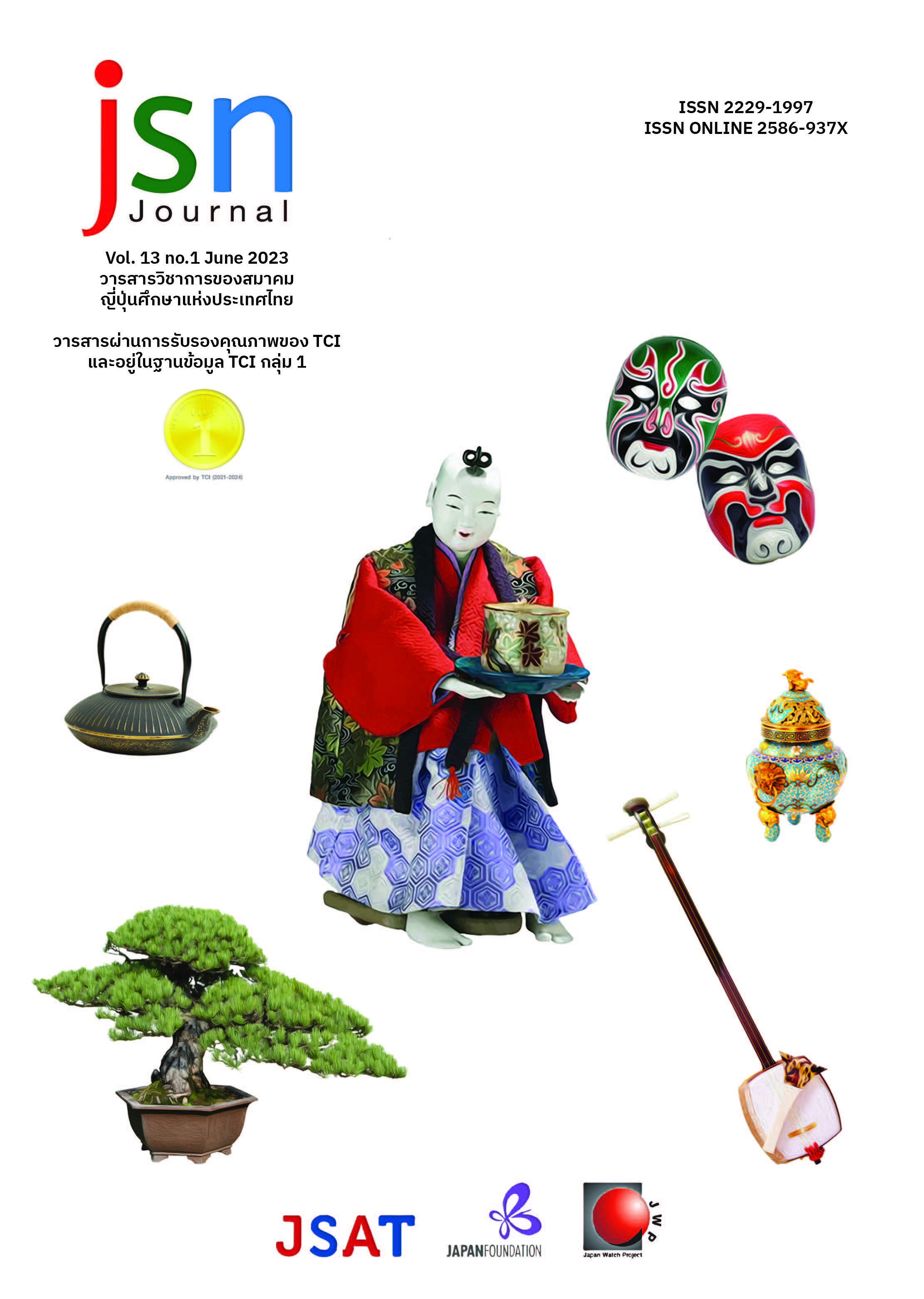Functions of the Discourse Markerでも in Casual Chats Among Thai Learners of Japanese
Main Article Content
Abstract
The discourse marker でも (demo) is considered one of the discourse markers that play a crucial role in conversation. The objective of this research is therefore to study the usage of でも in casual chats between Thai learners of Japanese and their Japanese friends to reveal the functions that でも serves for Thai learners of Japanese; the frequencies of the individual functions; and to discuss certain uses that are not natural sounding and that are incorrect. The findings indicate that the usage of the discourse marker でも has five functions, in descending order according to frequency of occurrence as follows: 1) expression of contrast, which is the same basic function as found with the most frequent occurrence among native Japanese speakers; 2) topic shifting; 3) topic development; 4) addition of information; and 5) comparison. The fact that the majority of uses of でも were for its topic shifting and topic development functions, as compared to uses for the other functions, demonstrate attempts to use でも as a conversational strategy to engage in a conversation where learners try to raise various issues to keep the conversation going. However, caution should be taken in the usage of でも regarding its topic shifting function, for some uses may give a conversational partner the feeling that the topic has shifted all of a sudden, and also in the usage of でも outside its actual scope of use, which may be influenced by the mother tongue, resulting in unnatural sounding or incorrect uses.
Article Details

This work is licensed under a Creative Commons Attribution-NonCommercial-NoDerivatives 4.0 International License.
ข้อความและข้อคิดเห็นต่างๆ ในบทความเป็นของผู้เขียนบทความนั้นๆ ไม่ใช่ความเห็นของกองบรรณาธิการหรือของวารสาร jsn Journal
References
ราชบัณฑิตสถาน. (2560). พจนานุกรมศัพท์ภาษาศาสตร์ (ภาษาศาสตร์ทั่วไป) ฉบับราชบัณฑิตยสภา. กรุงเทพมหานคร: เอบิซ อินเตอร์กรุ๊ป.
Sacks, H., Schegloff, E. A. & Jefferson, G. (1974). A simplest systematics for the organization of turn-taking for conversation. Language, 50(4), 696 - 735.
Schiffrin, D. (1987). Discourse Markers. Cambridge: Cambridge University Press.
磯野英治・上仲淳 (2016). 「日本語学習者がターン交替時に使用するディスコースマーカー:日本語母語話者との比較」『日本語研究』36, 87-95.
岩澤治美 (1985). 「逆接の接続詞の用法」『日本語教育』56, 39-50.
王琪 (2019). 「共時的観点からみた日本語逆接接続表現の文法化:自然談話の分析に基づいて」『言語文化論究』43, 27-44.
木暮律子 (2002). 「日本語母語話者と日本語学習者の話題転換表現の使用について」『第二言語としての日本語の習得研究』5, 5-23.
クワンチャイ,セークー (1999). 「会話における接続詞の「でも」について」『東京外国語大学日本研究教育年報』3, 21-42.
グループ・ジャマシイ (1998). 『教師と学習者のための日本語文型辞典』東京:くろしお.
近藤邦子 (2004). 「香港の大学における日本語学習者によるストーリーテリングの接続表現の問題点」『早稲田大学日本語教育研究』5, 77-92.
清水由貴子 (2017). 「逆接を表す表現」中俣尚己(編)『現場に役立つ日本語教育研究5コーパスから始まる例文作り』(135-158). 東京:くろしお.
曺永湖 (1996). 「談話における「でも」の機能について」『文化』59 (3.4), 17-230.
陳相州 (2008). 「日本語会話データに見られる対比談話標識の使用実態」『言葉と文化』9, 237-252.
筒井佐代 (2012). 『雑談の構造分析』東京:くろしお.
西阪仰・串田秀也・熊谷智子 (2008). 「特集『相互行為における言語使用:会話データを用いた研究』について」『社会言語科学』10 (2), 13-15.
初鹿野阿れ (1998). 「発話ターン交代のテクニック―相手の発話中に自発的にターンを始める場合―」『東京外国語大学留学生日本語教育センター論集』24, 147-162.
蓮沼昭子 (2022). 「取り立て詞「だって」について─とりたて表現の体系における「も」「でも」との対照─」『日本語日本文学』32, 18-35.
花村博司 (2015). 「日本語の会話における話題転換研究の概観:日本語教育に生かすための研究をめざして」『言語文化学研究』10, 65-102.
浜田麻里 (1995). 「サテ、デハ、シカシ、トコロデ―転換の接続詞―」宮島達夫・仁田義雄 (編)『日本語類義表現の文法(下)』(600-607). 東京:くろしお.
稗田三枝 (2003). 「会話の展開と談話標識-談話標識「でも」に焦点を当てて」『日本語・日本文化研究』13, 193-202.
安井永子 (2012). 「接続詞「でも」の会話分析研究:悩みの語りに対する理解・共感の提示において」『名古屋大学文学部研究論集 』58, 89-102.
若松史恵 (2021). 「話題開始部の冒頭に現れる言語形式についての一考察―談話標識「え」「ええと」「でも」「なんか」に着目して―」『社会言語科学会』24 (1), 173-188.


